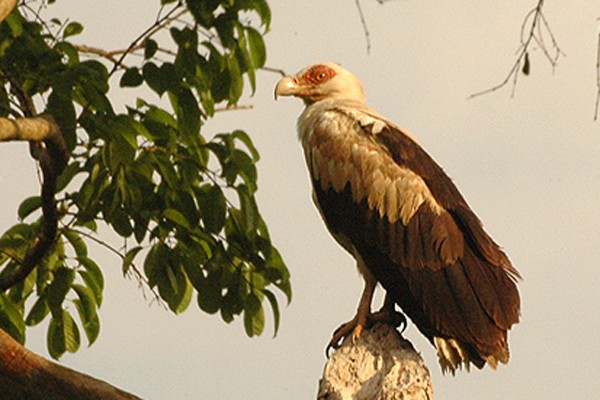Palm-nut Vulture
A species of Palm-nut vulture Scientific name : Gypohierax angolensis Genus : Palm-nut vulture
Palm-nut Vulture, A species of Palm-nut vulture
Botanical name: Gypohierax angolensis
Genus: Palm-nut vulture
Content
Description General Info
 Photo By Tom Tarrant , used under CC-BY-SA-3.0 /Cropped and compressed from original
Photo By Tom Tarrant , used under CC-BY-SA-3.0 /Cropped and compressed from original Description
This is a nearly unmistakable bird as an adult. At 1.3–1.7 kg (2.9–3.7 lb), 60 cm (2.0 ft) long and 150 cm (4.9 ft) across the wings, this is the smallest Old World vulture. Its plumage is all white except for black areas in its wings and tail. It has a red patch around each eye. The juvenile, which takes 3–4 years to mature, is brown with yellow eye-patches. In flight, this species resembles an eagle more than a typical vulture, and it can sustain flapping flight, so it does not depend on thermals. With its extensive white plumage, and black wing- and tail-feathers, the adult palm-nut vulture can be crudely mistaken for both the African fish-eagle and the Egyptian vulture, but clearly lacks the chestnut body of the former and the white tail of the latter The sexes are identical in appearance, with the female being the same size as the male. Juveniles on the other hand are predominately brown with partially black wings and take a lengthy three to four years to make the transition into the adult plumage 
Size
65 cm
Nest Placement
Tree
Feeding Habits
Palm-nut Vulture predominantly consumes oil palm fruit-husks and Raffia palm fruits, which constitute over 60% of its diet. Juveniles rely on these fruits for over 90% of their intake. Additionally, palm-nut Vulture preys on crabs, molluscs, frogs, fish, and locusts, and will eat small mammals, reptile eggs, hatchlings, domestic poultry, and carrion.
Habitat
Palm-nut Vulture's habitat predominantly encompasses coastal forests, mangroves, and wet savannas, where oil and raffia palms flourish. This species prefers tropical environments near water bodies, within a broad elevation range up to 1,500 meters, occasionally reaching 2,300 meters. Palm-nut Vulture adapts to both natural and cultivated palm settings, extending to drier, wooded savannas.
Dite type
Frugivorous
General Info
Feeding Habits
Bird food type

Fruit
Distribution Area
Palm-nut vultures are found throughout most of the coastal areas of the African continent from The Gambia to Kenya and as far South as South Africa. The total African population is estimated to be 80 000 pairs. There are approximately 40 birds in South Africa. 
Species Status
This species is widespread throughout much of Africa, overall fairly common and with a stable population. It is rarer and much more localized in South Africa, although not considered to be under any form of immediate threat in that country. That being said, the threats to this species in South Africa are not well understood. The low population size makes the species vulnerable to stochastic events. In Mozambique Parker (1999) observed that cutting down of coastal forest was threatening breeding habitat. The main threat to this species in South Africa is habitat loss. Open cast sand dune mining and urban expansion have reduced suitable habitats. The cultivation of Raphia palms for its ornamental value is currently increasing providing food and nesting sites. There is also a large portion of its habitat protected by the Isimangaliso Wetland Park. There are no current species specific conservation initiatives as this species is the only vulture species in South Africa where the population size is increasing. The importance of maintaining this is that the South African satellite population in producing dispersing birds that are contributing to maintaining the Mozambique population (and hence the larger metapopulation). 